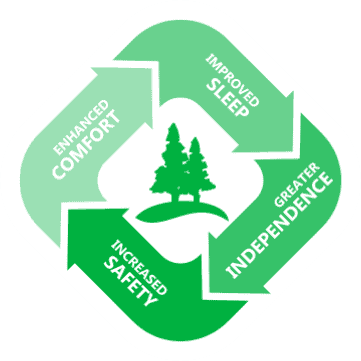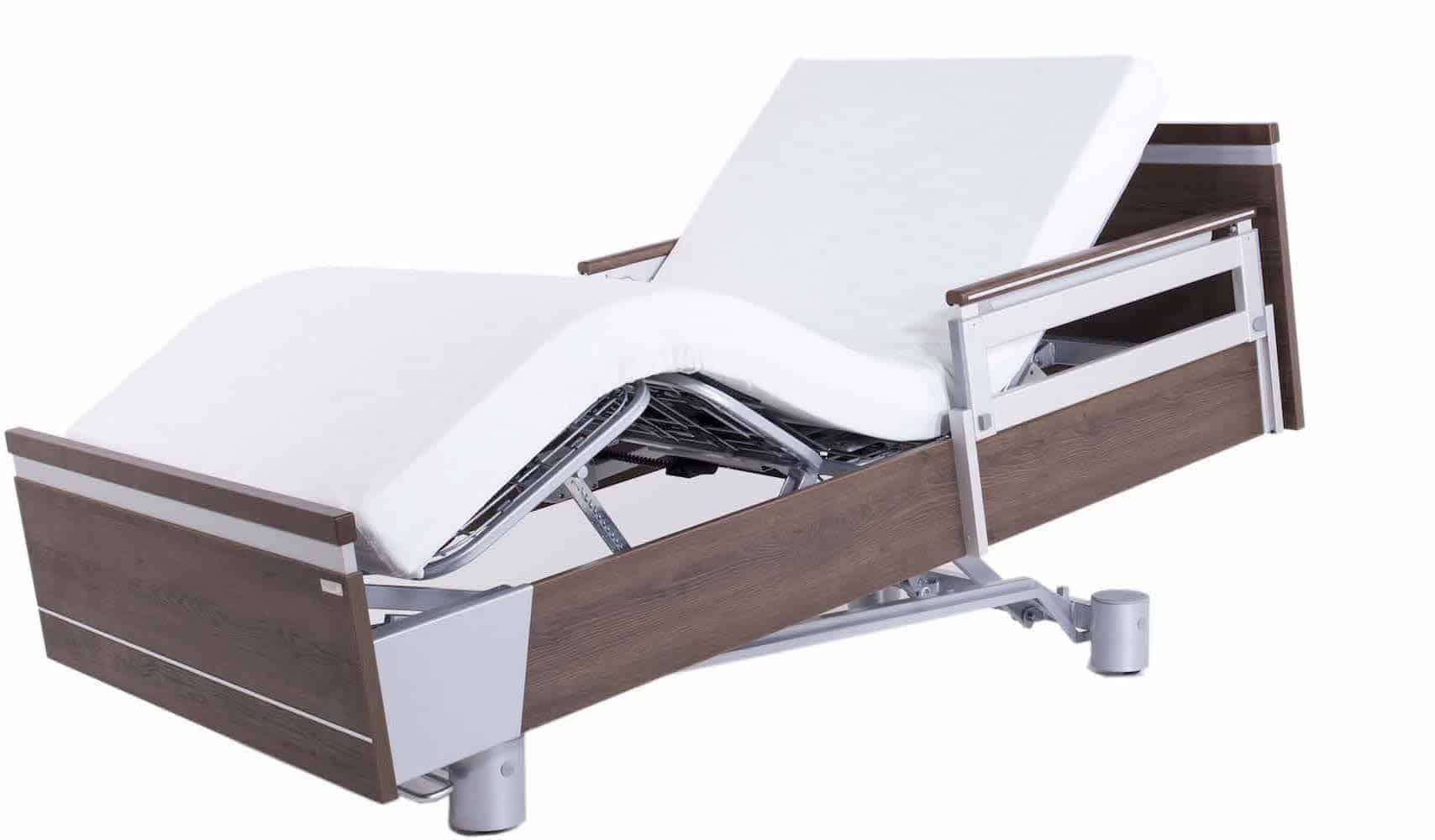Learn About How A Hospital Bed Improves Comfort and Independence for those with Spinal Cord Injuries
| Key Takeaways |
|---|
| ✅ Spinal cord injuries lead to long-term bed rest and chronic pain, with no current way to reverse the damage. |
| ✅ Hospital beds provide comfort and control for patients, helping prevent further medical problems and aiding in leading active lives. |
| ✅ The right hospital bed can help manage secondary issues like muscle contractures, pressure ulcers, bowel and bladder issues, respiratory infections, and blood clots. |
| ✅ Depending on the severity of the injury, a suitable bed and mattress can improve the patient’s quality of life, assisting with rehabilitation services and personal care. |
| ✅ Pressure-relieving mattresses on high-quality hospital beds are essential for skin protection, preventing bedsores and skin shearing. |
| ✅ SonderCare luxury hospital beds, equipped with supportive accessories, can be a crucial part of a comprehensive care plan for spinal cord injury patients. |
What Do Patients With Spinal Cord Injuries Need?
There isn’t any way to reverse any damage sustained to the spinal cord. While researchers are working on new treatments to promote nerve cell regeneration or improve the function of the nerves that remain after a spinal cord injury, as of right now, many effects will last a lifetime. Depending on the severity of the injury, many treatments focus on preventing further medical problems and empowering people with spinal cord injuries to lead active, productive lives.
The reduction in functional independence following a spinal cord injury has the most impact on many people. Often, immediate family or loved ones accept the role of caring for the affected person. However, many patients want to control their comfort levels, and in many cases can help advance their care process. A hospital bed is one way they can take more control over their surroundings.
Once the patient is stabilized and comfortable, they, their families, and the medical staff can work to prevent secondary problems: muscle contractures, pressure ulcers, bowel and bladder issues, respiratory infections, blood clots, and even mental issues like deconditioning. It’s vital that these patients have the right bed to mitigate and manage these issues. A hospital bed can be the key to those ends.
The educational interventions to people with spinal cord injuries and their families are still limited. A. Vasconcelos, Inácia Sátiro Xavier de França, Alexsandro Silva Coura, Francisco Stélio de Sousa, R. Q. Souto, Hemília Gabrielly de Oliveira Cartaxo. https://www.objnursing.uff.br/index.php/nursing/article/view/j.1676-4285.2010.3000 Medicine Online Brazilian Journal of Nursing
- There is currently no way to reverse damage to the spinal cord, and many effects of spinal cord injuries are likely to last a lifetime.
- Treatments focus on preventing further medical problems and enabling patients to lead active, productive lives.
- Spinal cord injuries often result in a reduction in functional independence, significantly impacting patients.
- The right hospital bed is crucial to mitigate and manage secondary problems such as muscle contractures, pressure ulcers, and respiratory infections.
Hospital Beds Have Suitable Features For A Spinal Cord Injury Patient's Relaxation & Rehabilitation
How severe a spinal cord injury is will determine a patient’s care level and the bed that will improve their quality of life. Many conditions rule out ordinary flat or adjustable beds, as they aren’t suited for the particular needs of recovery, rehabilitation, and mobility following the injury. Before someone with a spinal cord injury can leave the hospital, they or their loved ones must add a suitable bed and mattress for their home. The right choice can include technology that adjusts the firmness and position of the bed surface.
Once your loved one is home, members of their rehabilitation team will work with them to provide comprehensive care in the early stages of recovery. The medical care staff can be extensive and could include a physical or occupational therapist, a physiatrist (a doctor specializing in physical medicine or spinal cord injuries), a rehabilitation nurse and rehabilitation psychologist, and possibly even a social worker and a dietitian.
During the initial stages of rehabilitation, therapists usually emphasize maintaining and strengthening muscle function, redeveloping fine motor skills, and learning ways to adapt to day-to-day tasks. Many of these appointments occur in bed, and having a model that meets all these needs will be necessary; in most cases, a bed with few or no specialized features will only create more issues.
Hospital beds can assist with rehabilitation services to help patients with their strength and independence. High-low elevation lets the care worker move the mattress up or down, depending on their height or comfort level. Adjusting the head and feet can help them provide personal care, feeding, and other services.
Upper limb rehabilitation after spinal cord injury: a treatment based on a data glove and an immersive virtual reality environment.
- Severity of a spinal cord injury dictates the type of bed needed to improve the patient's quality of life.
- A comprehensive rehabilitation team provides care once the patient is home, involving various specialists.
- Initial rehabilitation focuses on muscle function, fine motor skills, and daily task adaptation, often requiring a suitable bed.
- Hospital beds with adjustable features aid in rehabilitation and enhance patients' independence.
Hospital Beds Can Protect The Skin Of Spinal Cord Injury Patients
A pressure-relieving mattress is essential for skin protection, which is the major concern among patients who cannot move independently following a spinal cord injury. After their injury, the nerves communicating sensations of discomfort or pressure may no longer work reliably. Skin and tissue damage can range from small changes in skin color to deep tissue injuries involving skin breakdown that affects muscles and bones.
High-quality hospital beds have pressure-redistributing mattresses that work to prevent problems associated with a loss of sensation, including bedsores and skin shearing. Prevention from these mattresses is important, as pressure-related injuries can take a long time to heal and disrupt everyday routines and activities.
Those with spinal cord injuries must also be conscious to protect their skin. Many medical professionals recommend shifting one’s weight every 15 minutes for 30 seconds to 1 minute. SonderCare luxury hospital beds have supportive accessories available, including the overhead trapeze helper bar and bed rails, that give those with injuries enough purchase to find pressure relief.
A hospital bed can be an essential part of any comprehensive care plan, including for those with spinal cord injuries. If you have a loved one with a complicated condition involving the spine, contact SonderCare today to learn more about how our premium care beds can make a big difference in their well-being.
- Severity of a spinal cord injury dictates the type of bed needed to improve the patient's quality of life.
- A comprehensive rehabilitation team provides care once the patient is home, involving various specialists.
- Initial rehabilitation focuses on muscle function, fine motor skills, and daily task adaptation, often requiring a suitable bed.
- Hospital beds with adjustable features aid in rehabilitation and enhance patients' independence.
From Our Experience... "Some of our clients used our beds in a long term and short term capacity for gaining rest and comfort with their spinal cord injury. The bed is designed to provide extra comfort for individuals who are bed bound from spinal cord injuries and degenerative disorders and also assist caregivers. We're happy to report great reviews and feedback from these valued customers."
Kyle Sobko Hospital Bed Expert
- Spinal cord injuries often lead to long-term bed rest and chronic pain. A hospital bed can provide comfort and control over their surroundings, which is crucial for their recovery.
- The severity of the spinal cord injury determines the level of care and the type of bed that will improve the patient’s quality of life. The right bed and mattress can include technology that adjusts the firmness and position of the bed surface.
- Hospital beds can assist with rehabilitation services to help patients regain strength and independence. Features like high-low elevation and adjustable head and feet can aid in personal care, feeding, and other services.
- A pressure-relieving mattress is essential for skin protection, a major concern for patients who cannot move independently following a spinal cord injury. High-quality hospital beds have pressure-redistributing mattresses that work to prevent problems associated with a loss of sensation, including bedsores and skin shearing.
- SonderCare luxury hospital beds have supportive accessories available, including the overhead trapeze helper bar and bed rails, that give those with injuries enough purchase to find pressure relief. They can be an essential part of any comprehensive care plan for those with spinal cord injuries.
Frequently Asked Questions About Spinal Cord Injuries and Hospital Beds
Hospital beds can be particularly beneficial for spinal cord injury patients due to their adjustability. The ability to raise and lower the bed, as well as adjust the head and foot sections, can help manage pain, improve circulation, and aid in the prevention of pressure sores.
Certain models of hospital beds offer specialized positioning features, such as Trendelenburg position, Reverse Trendelenburg position, and lateral tilt. These positions can assist in various clinical needs like easing respiratory distress, aiding in bodily functions, or helping with certain medical procedures.
By adjusting the bed position and using specialized mattresses or overlays, pressure can be redistributed away from vulnerable areas, which helps prevent pressure sores—a common issue for people with limited mobility.
Hospital beds can be raised or lowered to assist in safe transfers to and from the bed. They can also feature side rails to offer support and safety while repositioning in bed. Some models come with built-in trapeze bars to help patients with upper body strength move themselves.
Yes, hospital beds that offer various positions can be utilized during physical therapy sessions. For instance, elevating the foot or head section of the bed can aid in certain stretching and strengthening exercises.
The choice largely depends on the patient’s specific needs and their level of injury. Electrically adjustable beds offer the greatest flexibility and ease of use. Bariatric models may be necessary for larger patients, and low beds can be beneficial for those at risk of falls.














